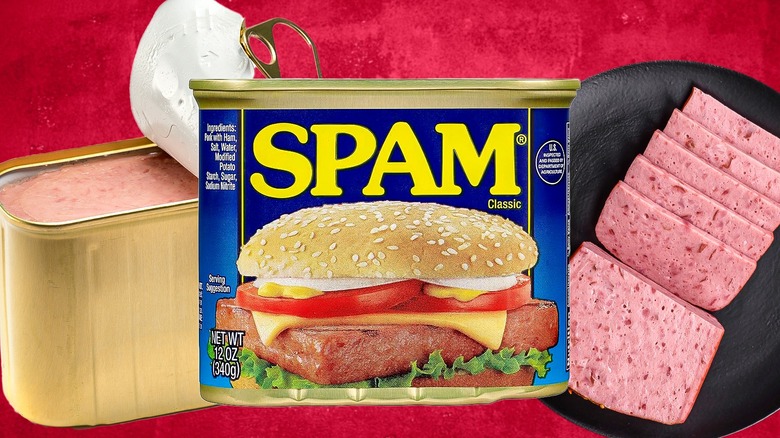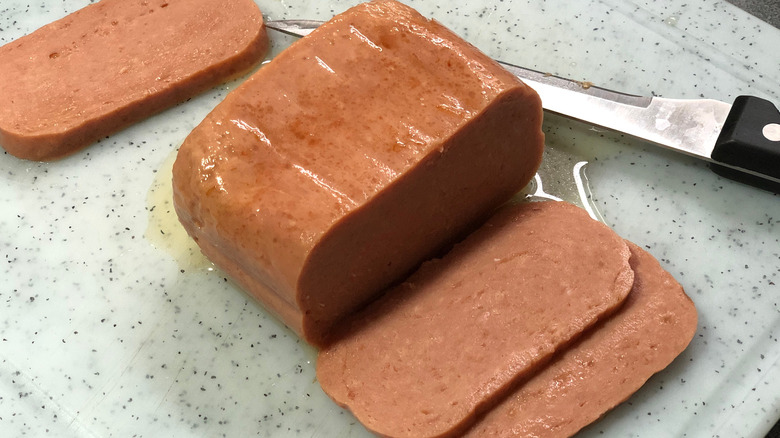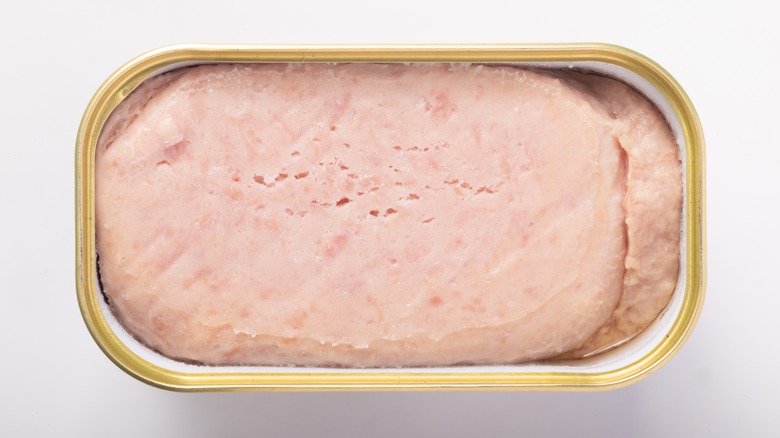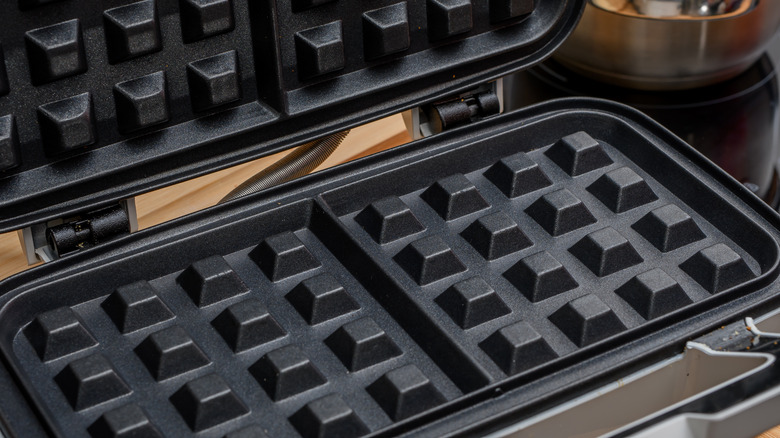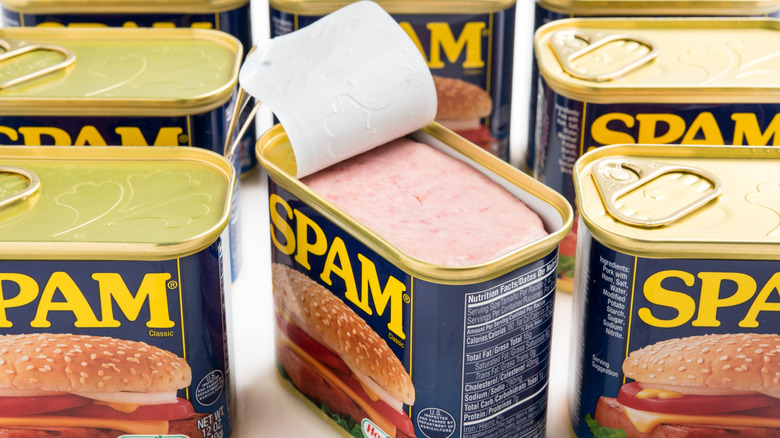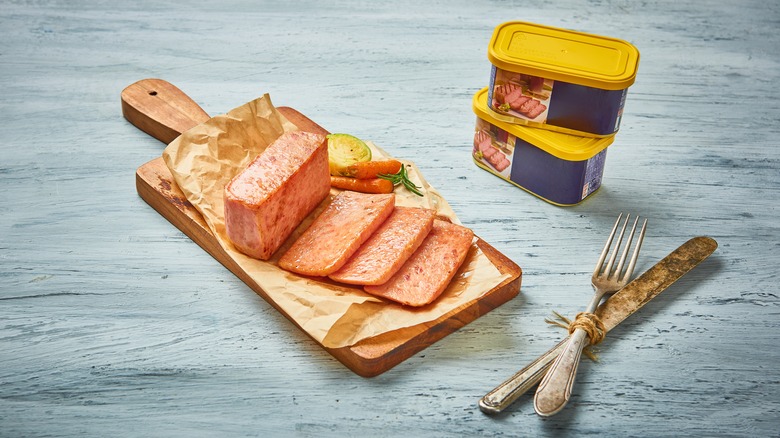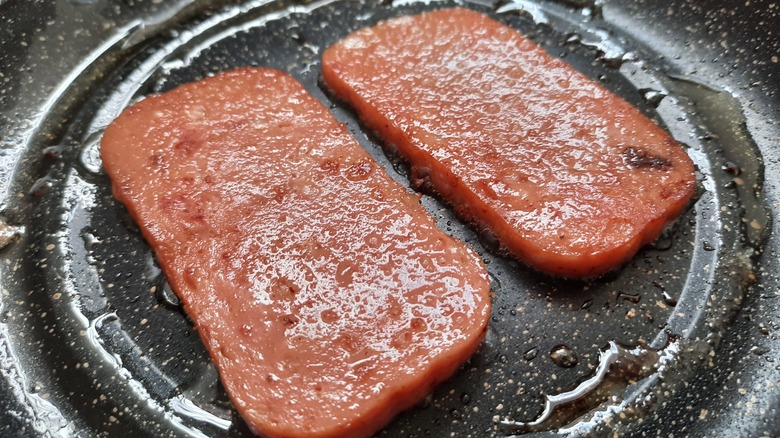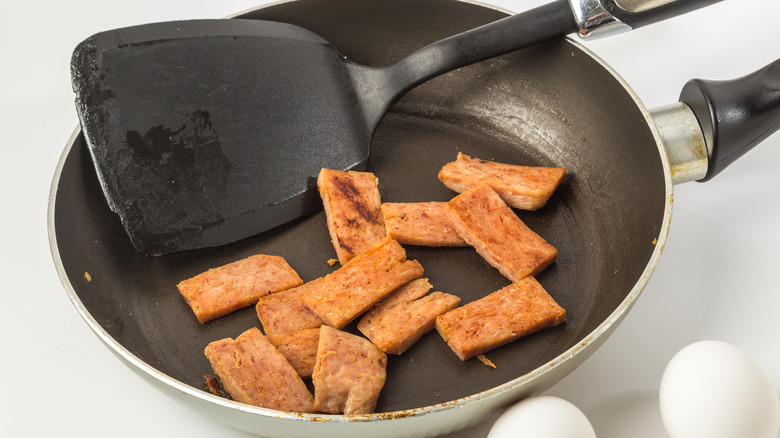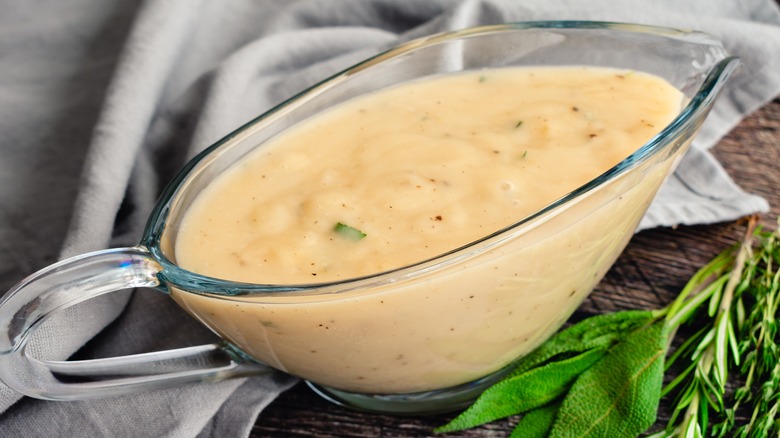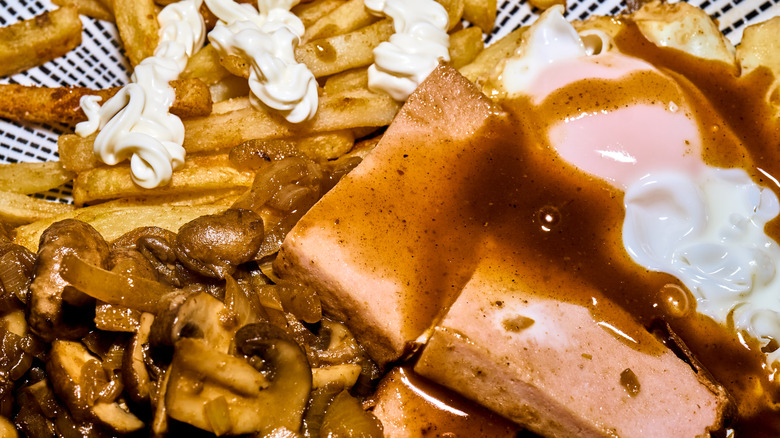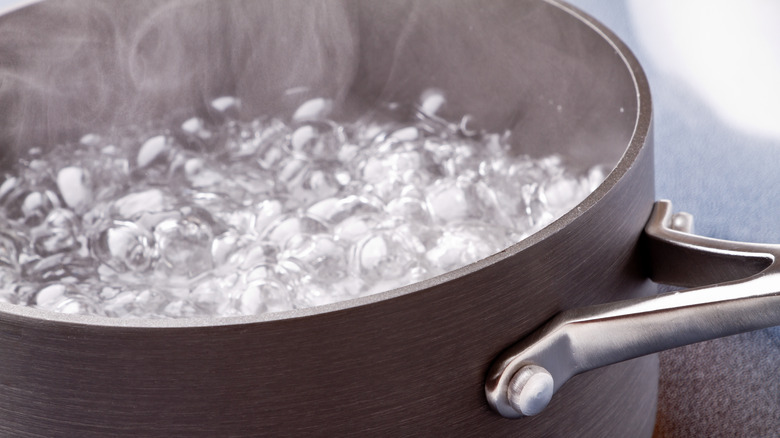15 Mistakes You Have To Stop Making With Spam
When someone says "canned meat," does your mind immediately flash to canned chicken floating in a swamp of its own juices? Perhaps you envision chewy Vienna sausages — but the most likely manifestation is Spam. The origins of what the Spam name really stands for are uncertain, with some sources suggesting that it was a portmanteau of "spiced ham," while others trace its title to its ingredients: shoulder of pork and ham (which is a mouthful, to say the least).
Hormel introduced Spam onto the market in 1937, but the product really saw its glory days during World War II. The meat was shelf-stable and very convenient for soldiers on the front lines. The recipe for this canned meat hasn't changed much; it still includes chopped pork and ham, salt, sugar, water, potato starch, and sodium nitrite as a preservative.
Spam's easily-recognizable blue-and-yellow can, as well as its integral role in dishes like Spam musubi, has garnered support from many eaters. But for other chefs, learning how to work with this unique ingredient is nothing short of a challenge. We've highlighted some of the most common pitfalls people make with this historic meat product, as well as some of the ways that you can ensure success when working with this salty canned concoction.
Re-cooking your Spam rather than eating it raw
Every single time we open a canned meat, it brings up the question: "To cook or not to cook?" Spam was initially created as a convenient protein that could be eaten straight from the can. So, you don't have to cook it in order to enjoy it.
If you like the crispiness of a grilled burger, then you'll love cooking your Spam before you eat it. This process gives it a texture that's very crisp, and it adds some texture to an otherwise gelatinous patty. It also helps distract from that unique pink color that might turn some eaters off to the idea of eating Spam.
There are some applications where you'll definitely want to cook your Spam before you take a bite. While it might not need to be cooked for thinly sliced deli sandwiches, pasta dishes, or breakfast sandwiches, sometimes the meat can really benefit from the contrast between Spam's soft interior and a crispy outside shell.
Giving up on opening the can
The hardest part of working with Spam isn't finding out how to cook it, selecting seasonings, or storing it: It's all about getting that darned can open in the first place. The tin is designed to preserve the meat after it's cooked — which helps contribute to its shelf-stable nature. But, this also makes trying to wedge the can open a real challenge.
The best technique for easier removal of your Spam from the can is to puncture it, which will release the vacuum seal. You'll want to gently take a knife — not your prized, expensive chef's knife — and poke a hole in the bottom of the can to depressurize it. Then, when you pop open the can using the tab, the meat should slide out easily, without forcing you to mangle it in order to wedge it out of the can.
There are other methods you can use to unstick your Spam from the can without having to sacrifice a knife. If you run the base of the can under warm (but not piping hot) water, it may help reduce the stickiness of the meat and better allow it to slide out of the can and onto your cutting board. When all else fails, a spatula may also help wedge the meat from its packaging.
Only cooking Spam on the stovetop
When thinking about how you should try cooking Spam, one of the immediate tools that comes to mind is the humble skillet. While there's nothing wrong with this conventional cooking method, which has served us well in the past, there are more unconventional tools that you can put to use when it comes to this canned meat. One is a staple of brunches everywhere: the waffle iron.
The waffle iron's shape maxes out the crispiness of Spam and gives it a unique shape. You won't even need to oil your iron ahead of time; just place a thin slice on the iron and press down until your meat is perfectly cooked and dappled.
Alternatively, you can slice and air-fry your Spam for a crisp, meaty take on fries. Once your Spam is thinly sliced and seasoned, pop it in your tabletop appliance until it's perfectly crisp and just begging to be dipped into a sauce.
Keeping an opened Spam can for too long
There are urban legends about Spam's ability to survive a nuclear apocalypse, but that would really only apply if the canned meat remains vacuum-sealed in its original packaging. Once you break the seal on the can, all bets are off.
The proper way to store leftover Spam is to place it in its can and cover the top. This method will keep your canned pork fresh for up to five days, but for a longer period of time, you'll need to freeze it. As with all foods, the meat's quality will diminish after you pop it into the freezer, but it's still safe to eat for up to three months. Ideally, you'll want to parcel the canned meat into smaller pieces and wrap each individually.
Your Spam will let you know when it's ready to be tossed into the trash. The easiest indication for how to tell if Spam has gone bad is to take a big whiff. An odd odor, often combined with an off color or slimy texture, is a clear indication that it's time to evict this canned meat from your fridge.
You should also be vigilant about examining your Spam can before you open it. Leaks, swelled containers, and dents along the edges and seams of the can may indicate that the vacuum seal has failed. Eating it may increase your risk of contracting botulism, so you should just toss it out and buy a new can.
Slicing your Spam too thin or too thick
Like other foods, the optimal size that you choose to slice your Spam really depends on the recipe you're using it for, and how you plan on eating it. Failing to slice your Spam to the correct thickness will lead to issues with texture, and possibly under- or over-cooking it.
We will be the first to admit that we're not the best at slicing things evenly. Eyeballing anything is tough, and we're grateful that there are a variety of different cutting implements to help evenly slice Spam into equally sized pieces for whatever you plan on making.
If you want to convert your Spam into deli slices for a sandwich, we recommend purchasing an electric meat slicer to ensure that you're getting super-thin slices. It's probably cheaper than you'd think, and it pays for itself if you buy cheese, meat, and bread in bulk — or if you just want to find a new way to use up your can of Spam. In search of thicker slices for breakfast sandwiches and Spam musubi? Then opt for a stainless steel luncheon meat slicer for your kitchen. This makes it easy to cut not only Spam, but also eggs, soft fruits, and more.
Cooking your Spam in too much oil
Cooking oil is something we constantly find ourselves adding to the pan — even if the food we're preparing doesn't need it. After all, shouldn't you oil a non-stick pan, just in case?
When it comes to cooking Spam, you'll need to leave your container of cooking oil in the cabinet. Adding extra oil to the pan can result in an unnecessary Spam-cooking disaster. The meat itself contains enough fat to cook perfectly; no additional oil is needed. If you choose to splash some extra vegetable oil into the pan for good measure, you'll risk splattering oil over every conceivable surface in your kitchen — and potentially your exposed arms, too.
If you manage to get away from your cooking nightmare unscathed, the best-case scenario is that you'll end up with an oil-drenched piece of meat. Just move it straight from the cutting board to the pan.
Not considering Spam as a legitimate, useful protein
Spam is one meat that always gets the short end of the stick. It's the butt end of jokes, and it's a food that people rarely take seriously. But, rest assured that there are many creative ways to use canned Spam — it might just require some extra effort to get it to the place that it needs to be.
One of the best ways to transform your Spam is to integrate it into other foods. Adding it to a breakfast hash, roasted Brussels sprouts, or fried rice can seamlessly integrate it into other recipes. You'll feel less like you're biting into a solid block of canned meat and more like you're eating an umami-rich, complete meal.
You can also use Spam as a creative substitute for other proteins. For example, consider swapping pulled pork for canned Spam for umami-packed sliders that your game-day party attendees will love. You can add caramelized onions, sauces, or something pickled to give your sandwich a unique edge and distract from the meat's mealy texture.
Going overboard with other salty ingredients
We're not going to lie and say that Spam isn't salty. A classic can of Spam contains 790 milligrams of sodium for each 2-ounce serving — about a third of your recommended daily allowance of sodium. But, you probably don't need the nutrition label on the back of the can to tell you that this meat is salty; one bite will tell you all you need to know about this preserved meat product's saline nature.
As a result, you'll want to tone down other salty flavors that you may cook with your Spam, to avoid overwhelming your taste buds. While other piquant ingredients may help up the ante for spiciness, they can also contribute to the salty character of the dish. Opt for low-salt condiments, or seek out balancing acidic or fatty ingredients to give your dish a more well-rounded flavor portfolio. Alternatively, you can also use a low-sodium Spam product instead of the classic variety.
Forgetting to season your Spam
Spam straight from the can leaves a lot to be desired. It's gelatinous and gooey, and besides saltiness, it really lacks any sort of discernible flavor. In order to give your Spam some oomph, you'll need to take a trip to the spice rack.
The exact seasoning (or blend of seasonings) to use will depend on what you're making. While you'll want to avoid any seasonings that are sodium-based, and exercise caution with spice blends that have a salty element, the world is your oyster when it comes to a block of canned Spam. For example, for a simple Spam musubi recipe, you'll want to grab soy sauce, brown sugar, and mirin. You can also add this seasoning back into the pan after you've cooked the Spam and let it reduce into a savory-sweet glaze.
Other great seasoning options for Spam include international spice blends like za'atar or jerk seasoning. You can also DIY your own seasoning with aromatics and herbs like rosemary and thyme, and warming spices like paprika, chili powder, and cumin.
Not trying other types of Spam
When most people think of Spam, what comes to mind is the brand's classic product. But there are more Spam flavors than you might expect. The first two products that the brand released with alternative flavors were hickory-smoke Spam and Spam with cheese, but the brand has since expanded to include a total of 11 different offerings. Some are regionally specific, like the Spam with tocino seasoning (one of the essential Filipino ingredients), while other varieties are more global in scope.
The type of Spam you choose will depend on what you plan to eat it with. Teriyaki-flavored Spam would be a great, flavorful accompaniment to your Spam musubi, while the Spam with bacon would be an excellent two-for-one addition to a breakfast hash or pairing for eggs. You can even go with the maple-flavored Spam if you like the sweet-salty mashup. There are also Spam varieties for folks who are looking for low-sodium or low-fat options.
Overcrowding your pan
We've all had those moments in our cooking experience when we select a pan and cross our fingers while hoping that it will be large enough to fit everything we're making. When you're working with Spam, overcrowding your pan is a big no-no, because it could potentially lead to undercooked, less-than-crispy Spam.
The truth is that even Spam needs space in the pan to cook, and you can ensure your success with it by selecting a pan that is large enough to accommodate all the pieces that you plan on preparing. This tip is important for Spam slices and Spam cubes that you'd add to your eggs or hash. A larger pan will more readily allow you to tell when it's time to flip your Spam so that you not only prevent having oily, soggy Spam, but also don't leave your meat in the pan for so long that it burns.
Tossing out the drippings
The best part about cooking meat isn't always just having the meat itself. It's also the fact that the cooking process renders delicious, useful fat that can be used for a variety of culinary applications. While you can upgrade your recipes with bacon grease or save the leftover steak juice for a sauce, you can just as easily collect Spam's leftover drippings to use for other things.
One of the best hacks for using up the leftover drippings is to cook the meat down in a pan. Then, you can remove the meat itself from the pan and stir up the leftover fat with a splash of milk to add extra creaminess to the mixture. From there, you can also add aromatics or extra ingredients to thicken your gravy before slathering it on top, or using it for another recipe entirely. Plus, it also saves you the work of trying to mop up the residual oil in your pan with a paper towel.
Only using Spam for savory recipes
On the long list of ways to use Spam, you'll come across things like ramen, musubi, and breakfast sandwiches. The main similarity that a lot of these recipes share is that they're exclusively made with savory ingredients. Besides some sweet additions like mirin or brown sugar, Spam rarely sees anything on the sweet side of the spectrum — and that's a shame.
You can use Spam to make sweet things; you just have to get creative. Spam's social media team even shared a photo of a brownie topped with ice cream and Spam to show just how versatile this protein can be. In theory, you could use Spam in similar dessert recipes that you could enhance with bacon. Think of Spam as an upgraded savory ice cream topping, donut decoration, or even as a salty addition to your favorite cookie recipe. You just have to be okay with thinking out of the box — or can.
Serving Spam without removing excess oil
After your Spam comes out of the frying pan, it's going to be an oily mess. However, there are some steps you can take to remediate this oily residue and ensure that your meat comes out perfect. Similarly to when you cook bacon, you should always have a drying space at the ready to soak up the oil from your meat.
You might at first think to use a large wire rack, like the one you'd use for cookies, to allow all that grease to drip off of your Spam — but the best thing for drying your Spam is actually a paper towel. The paper towel uses capillary action to soak up all that oil more effectively than a wire rack ever could. But that's not to say that this method doesn't have its issues. To help the grease drain from your Spam more effectively, you should use the same paper towel hack for draining fried chicken — crumple up the paper towels to maximize the drying space. This technique leaves exposed pockets for airflow, which will allow your Spam pieces to get the perfect level of circulation underneath to cool off and drip-dry without becoming too soggy.
Forgetting to boil Spam to remove its saltiness
Take that vision of "boiled Spam" out of your mind for a hot minute. Although it seems counterintuitive to make a gelatinous meat more gelatinous by boiling it in hot water, this cooking method actually has its place in the kitchen. When you plop your Spam into the hot water, it will start drawing out the salt from the meat, which helps temper its flavor. And interestingly enough, your Spam won't disintegrate into the hot water like other types of protein would. The meat might come out slightly spongy, but it's a fair price to pay when you want to pair your Spam block with salty seasonings to give it more flavor.
If you don't have a pot handy, you can also try to soak the meat in cold water to extract some of the saltiness from it. Regardless of the method that you use, you should always transfer the Spam to a separate surface to ensure that the water can drain from it before you use it in your recipe.
Static Media owns and operates Tasting Table, Mashed, and The Daily Meal.
